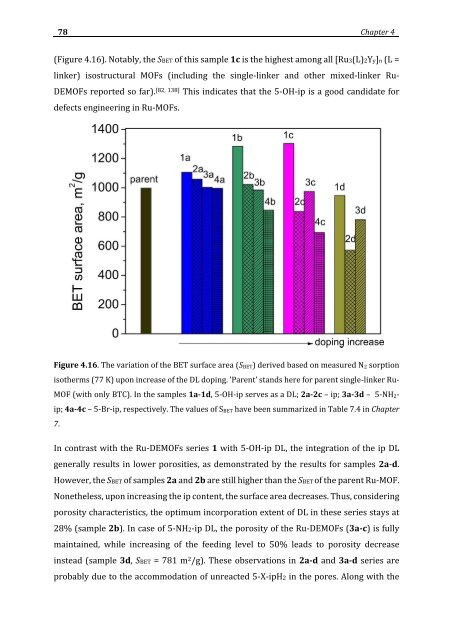Create successful ePaper yourself
Turn your PDF publications into a flip-book with our unique Google optimized e-Paper software.
78 Chapter 4<br />
(Figure 4.16). Notably, the SBET of this sample 1c is the highest among all [Ru3(L)2Yy]n (L =<br />
linker) isostructural MOFs (including the single-linker and other mixed-linker Ru-<br />
DEMOFs reported so far). [82, 138] This indicates that the 5-OH-ip is a good candidate for<br />
defects engineering in Ru-MOFs.<br />
Figure 4.16. The variation of the BET surface area (S BET ) derived based on measured N 2 sorption<br />
isotherms (77 K) upon increase of the DL doping. 'Parent' stands here for parent single-linker Ru-<br />
MOF (with only BTC). In the samples 1a-1d, 5-OH-ip serves as a DL; 2a-2c – ip; 3a-3d – 5-NH 2 -<br />
ip; 4a-4c – 5-Br-ip, respectively. The values of S BET have been summarized in Table 7.4 in Chapter<br />
7.<br />
In contrast with the Ru-DEMOFs series 1 with 5-OH-ip DL, the integration of the ip DL<br />
generally results in lower porosities, as demonstrated by the results for samples 2a-d.<br />
However, the SBET of samples 2a and 2b are still higher than the SBET of the parent Ru-MOF.<br />
Nonetheless, upon increasing the ip content, the surface area decreases. Thus, considering<br />
porosity characteristics, the optimum incorporation extent of DL in these series stays at<br />
28% (sample 2b). In case of 5-NH2-ip DL, the porosity of the Ru-DEMOFs (3a-c) is fully<br />
maintained, while increasing of the feeding level to 50% leads to porosity decrease<br />
instead (sample 3d, SBET = 781 m 2 /g). These observations in 2a-d and 3a-d series are<br />
probably due to the accommodation of unreacted 5-X-ipH2 in the pores. Along with the
















